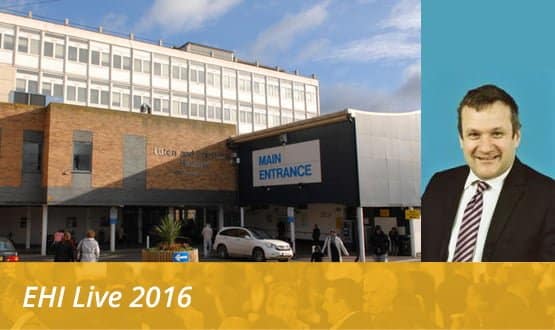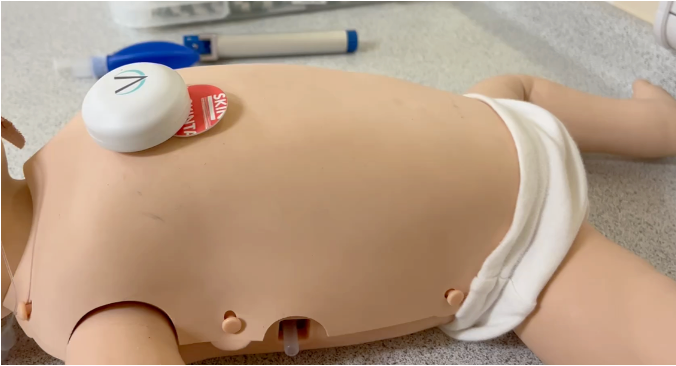Interview: Mark England
- 24 October 2016

Mark England is a busy man. On the day that Digital Health News speaks to the director of reengineering and informatics at Luton and Dunstable NHS Foundation Trust, he is juggling two big deadlines.
The first; a submission to NHS England to secure the trust’s status as a ‘global digital centre of excellence’ as part of the exemplar programme that came out of Professor Bob Wachter’s review of NHS IT.
The second; the submission to a whole set of NHS arms’ length bodies of the sustainability and transformation plan that the trust is leading on behalf of 16 organisations across Bedfordshire, Luton and Milton Keynes.
This is the vehicle for taking forward the ‘Five Year Forward View’ plan to close a £30 billion gap between NHS funding and demand by 2020-21 and, therefore, to secure the sustainability of health and care services for one million people locally. No pressure then.
Best of breed – and its limits
England joined Luton and Dunstable in 2008, having been the chief information officer for children’s services in Croydon. In doing so, he became the IT director of a trust that was taking a ‘best of breed’ approach to implementing and electronic patient record.
The trust still uses the iSoft (now CSC) iPM patient administration system that it installed in 2001. But it has added other systems to get to the point where it is doing all of its ordering and prescribing electronically, has rolled out electronic observations on its wards, and has eliminated persistent paper thanks to a big scanning project with Xerox.
England says the trust is now reaching the limits of what it can achieve with this approach, because, eventually, it becomes difficult to make sure that clinicians are getting consistent alerts and decision support from the systems they are using.
“When you are synchronising across systems, that is when you need a unified electronic patient record,” he says; although he’s under no illusions about how synchronised some of the systems on the market are in practice. “So, we know we need to consolidate.”
A rapidly changing landscape
At this point, though, the rapid changes to the NHS landscape triggered by the pressing need to generate efficiency savings and respond to the Forward View come into play.
Luton and Dunstable needs to consider the wider environment in which it is now working. That includes collaborating with other acute trusts within the STP footprint: Bedford and Milton Keynes, one of which is also using iPM, and one of which has just decided to implement Cerner Millennium.
It also includes the other provider organisations in the STP footprint area, which brings in mental health, community and primary care, where local GPs and community services use TPP. Social care is also vital to the system; but uses a range of applications.
“We need to look outside individual trusts, which is what we used to do,” he says. “We have three hospitals on our patch, and we need to increase collaboration between them, but also beyond with the community settings. We need a health information exchange. We need to link into TPP.
“As an STP, we are focussed on implementing the Forward View, and can see the need for new models of care locally, with more accountability for the whole continuum of care.
“Models in which providers receive a capitated budget to care for their local population are clearly the future, and that means bringing in social care as well. So, suddenly, you are not talking about an EPR, but an EHR – an electronic health record – to support all of that.”
A global digital centre of excellence
With all of these strategic decisions to be made, the trust still jumped at the chance to become an exemplar when NHS England announced a £100 million pot to fund up to 12 trusts to learn from the best internationally and to become local digital leaders.
England said one of the big reasons for this was that the trust has made relatively little fuss about its progress to date, and global digital exemplar status will be a reward for all the hard work that its clinicians and IM&T team have put in.
Pragmatically, he also hopes that it will help with recruitment, which can be difficult for a trust on the outskirts of London, and with securing relationships with suppliers. He’s looking forward to working with and learning from other exemplar organisations.
And there’s no doubt the money will come in handy. “The money will accelerate some areas of development,” he says. “We hope we will be able to do in two or three years what we were otherwise planning to do in four or five.”
Using data to frame the future
As director of reengineering and informatics, though, much of England’s time is spent working on the STP, and supporting its senior responsible officer, Luton and Dunstable’s chief executive, Pauline Philip. The STP has taken a place-based demand-focussed approach to its work, rather than an institutionally focussed one.
“We have started by looking at the demand in the system, rather than by looking at the organisations that supply services at the moment,” England says, on the reasonable assumption that understanding future demand is likely to show what services are actually needed, and where.
“That is leading us to conclusions about the need to provide more care out of hospital, closer to home, to intervene earlier, to stop disease progression, and to increase efforts on prevention,” he adds. “That’s all consistent with the Forward View.”
The STP appointed Optum as a partner, and has worked with it to collect three years’ worth of anonymised data from its 16 participating organisations. In an interesting move, it has brought in actuaries to start making predictions based on this information.
“If you look at the US [which has been shifting its insurance-funded health management organisations towards an accountable care organisation model for some years] then actuaries are very much part of the system,” England says.
“Here, we tend to think of actuaries as the people who work out your insurance contributions, but they are experts at working out risk – and there is a lot of risk in the system.”
Still all about people
Moving forward, the STP expects to make more use of information to risk stratify its population, and to focus resources on those who most need them, and who are most likely to otherwise end up in hospital.
Luton and Dunstable NHS Foundation Trust might, unusually, be in financial balance and meeting its A&E targets, but its A&E attendances are still rising by a frightening 7-8% a year.
The STP has also made digitisation one of its themes. England argues that technology is probably as important as workforce in bringing about the changes that it will need to bring about, once NHS England has signed off on the plans, and given the ok to start communicating them to the local community.
However, when he’s asked what he’s learned so far, and what other Digital Health News readers engaged in STPs might learn from Luton’s experience, he doesn’t pick anything IT-focused. Instead, he talks about people.
“Change happens when people talk to other people,” he says. “In a system as complex as an STP, there are a lot of partners, and you have to secure trust to move forward.
“Some of the organisations in our area are used to working together, but some relationships are new. So it is a social journey that we are on; one in which we are all getting used to working together for the benefit of our patients.”





